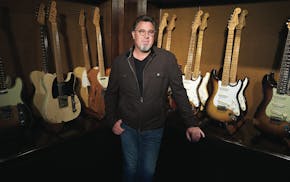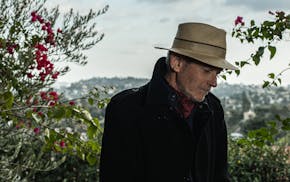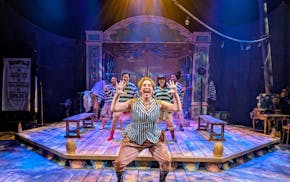Before the interstate highway system arrived in the 1950s, all manner of roadside oases enticed motorists to stretch their legs and open their wallets.
Many of those oddball museums, petting zoos and gift shops have long since gone by the wayside. (Probably a good thing in the case of a couple infamous Up North oddities where tourists fed marshmallows or soda to captive bears.)
But there's a reason Minnesota's favorite tourist traps and throwback attractions have remained as travel traditions. In a bland landscape of fast-food and fuel chains, these quirky pit stops are a fresh sight for road-weary eyes.
They may not be as storied as Wall Drug or House on the Rock, but they're well worth hitting the brakes.
Tom's Logging Camp Knife River, est. 1956
About 15 miles northeast of Duluth along Scenic 61, the trading post at Tom's Logging Camp sells memoirs by local game wardens ("Poachers Caught!"), football-size pinecones and toilet paper holders shaped like bears. Somewhere between the wool socks and faux feather headdresses, a shopper picked up a fake eyeball with a glint of recognition in her real one: She and her sister had once pranked their parents with such a thing. Proprietor Bill Weckman grinned from behind the counter. "That's why we get that stuff," he said.
After Weckman and his wife, Lauren, took over the business from her father (who had acquired it from founder and namesake Tom Deebach), they hardly changed a thing. That includes the vintage wall decor: beaver pelt, bison head and handmade buckskin coat, along with a pair of deer skulls, entwined by the antlers. (An aging photo of the bucks' carcasses explains that they were found in Superior National Forest: "They locked antlers while fighting and died of starvation.")
Tom's namesake logging camp is a plein-air museum offering a window into life as a lumberjack in northern Minnesota in the late 1800s and early 1900s. Deebach, a prolific collector, acquired the obsolete logging equipment after it was discovered in a storage shed. He decided to monetize it when his wife "threatened him with the bonfire of the century," Lauren says, by displaying it at the North Shore property he'd won in a card game, according to lore.
The $5 self-guided tour begins at a horse-drawn sleigh carrying a water tank used to make ice roads (to ease the hauling of massive log loads). There's a harness shop with a horse-shoeing stall, along with enormous round sawblades and other tools of the lumber trade. The bunkhouse and cook shanty describe austere living conditions: Beans and prunes were staples of the lumberman's diet, and lice often dropped from upper to lower bunkmates.
Like many a roadside attraction, Tom's is defined by its eclectic displays, which include llamas to feed and an antique-filled "odds and ends" shed that houses, of all things, a decommissioned electric chair that supposedly killed 14 people.
5797 North Shore Drive, Duluth, 218-525-4120, open May–Oct., (tomsloggingcamp.com
Treasure City Royalton, est. 1962
Kids strike it rich at Treasure City, a jam-packed trove of baubles and tchotchkes. Little hands touch everything within reach: lucky rabbits' feet, stink bombs, switchblade combs. One kid picked up a coin in a glass bottle and asked, "How do they get a penny in here? Magic?" Another had birthday money burning a hole in her pocket. "Dad, can I get this? I'll pay for it!"
Instead of an X to mark the spot, the area's largest souvenir shop is divined by the enormous pirate sign along the well-trod path between the Twin Cities and the Brainerd Lakes Area. (Hwy. 10's summertime bumper-to-bumper backup has been commemorated by Surly Brewing Company's IPA Treasure City Traffic.)
Robert Janski has owned the shop since the late 1970s and, with the help of his daughter-in-law Jennifer, curates all manner of curious tokens you never knew you needed.
That includes crystals and cowboy hats and coconut bras. Weaponry real (an actual crossbow) and fake (toy pirate swords). Tools for suctioning out mosquito-bite saliva and tins of shredded beef-jerky "chew." Geodes and personalized Minnesota license plate key chains. Shot glasses and fish-shaped cribbage boards, MAGA gear, alligator-claw back scratchers, corncob pipes, and a mug featuring a shivering squirrel who "froze my nuts off in Minnesota." Beaded belts, dreamcatchers and tiny treasure chests to fill with shiny baubles.
The bestselling item is geared toward the indecisive: gender-segregated "surprise packages." Like the shop itself, you never know what you'll find inside.
308 Hwy. 10, Royalton, Minn., 320-584-5140, treasurecitymn.com
Minnesota's Largest Candy Store, Jordan, est. 1960s.
The only way to track down Minnesota's Largest Candy Store is to make an in-person visit — lacking, as it does, any sort of website, social media account or even a phone. Fortunately, the hangar-sized banana-yellow beacon along Hwy. 169, southwest of Minneapolis, is impossible to miss. It was originally a barn for the Wagner family's orchard. In the mid-2000s, after hail damaged their crop, Herbert "Hippy" Wagner diversified by selling candy.
Today, his son Robert oversees the unfathomable array of treats at this funhouse filled with elaborate murals, comic book character statues and even an animatronic candy band.
The shop stocks old-fashioned sweets including Necco Wafers, which date back to before the Civil War and now seem about as appealing as eating chalk. There's also ribbon candy, Black Jack Gum, those little wax bottles filled with sugar water and so, so many packs of candy cigarettes.
Some treats are common (PEZ, fudge), others rare (Edible Snow, chocolate-covered crickets). Highbrow (local B.T. McElrath chocolates) and low (a cupboard of novelty gum labeled "for adult eyes only"). International (Lindt, Ritter Sport) and unrecommended (French burnt peanuts, Boston baked beans). There is every form of gummy imaginable, down to gummy brains and gummy chicken feet.
The overflowing soda, er, pop selection includes flavors as strange as mustard, ranch dressing, grass, butter, bacon and buffalo wing. More natural are the delicious homemade pies. And the foodstuff that started it all: apples.
20430 Johnson Memorial Drive, Jordan, open May-Nov., cash only
LARK Toys, Kellogg, est. 1983
Just south of Wabasha, Hwy. 61 passes what might best be described as Minnesota's outpost of Santa's Workshop.
Donn Kreofsky, an art professor, started LARK Toys (an acronym for Lost Arts Revival by Kreofsky) with his wife, Sarah, to sell handmade wooden playthings. Today's visitors can still peek into the shop's windows to watch woodworkers cut, sand and stain puzzles, play sets and small wheeled animals and vehicles.
The toy workshop grew into a massive attraction lauded as one of the 10 Best Toy Stores in the World by USA Today, and is now operated by Kathy and Ron Gray, along with their daughter and son-in-law, Miranda and Scott Gray-Burlingame. There's a toy store, bookstore (complete with a secret bookcase door), an 18-hole mini-golf course, resident llamas and a cafe/sweet shop known for its homemade fudge.
A hall called "Memory Lane" displays a century's worth of antique toys, from Howdy Doody and those little green army guys to Barbie dolls and Erector Sets.
LARK's biggest attraction is the carousel designed by Donn Kreofsky, with a hand-carved and -painted pig, flamingo and dragon. The carousel runs every half-hour (rides cost $3) and is enjoyed by young and old — a couple in their 90s recently took a spin on the backs of a loon and a goldfish.
63604 170th Av., Kellogg, Minn., 507-767-3387, larktoys.com
Niagara Cave, Harmony, discovered in 1924
The rugged landscape of Bryce Canyon National Park in Utah was once famously described as "a hell of a place to lose a cow" by Mormon pioneer Ebenezer Bryce, the park's namesake.
Niagara Cave, a tourist attraction near the Iowa border in Harmony, Minn., might be described as a hell of a place to lose a pig.
The limestone cave was discovered in 1924 when three little pigs ran away from a local farm and fell down a sinkhole. Some intrepid farm hands sent to find the pigs rescued them after they had slid about 55 feet below the surface.
Next came entrepreneurial cave explorers who mapped out the extent of the cave. They installed stairways and paths and opened it to tourists in 1934. Ninety years later, the privately owned cave, which has been run by three different families over the decades, is still drawing 25,000 to 30,000 visitors a year.
The one-hour guided tour ($20.95 for adults, $12.95 for kids), involves about a mile of walking and going up and down 275 steps. You'll see a 60-foot-high underground waterfall fed by an underground stream and 450 million-year-old fossils of marine animals embedded in the cave walls.
You'll learn the different types of cave formations — stalactites, stalagmites — and some fun and weird cave trivia: The first wedding held in the cave occurred only a year after it was opened to visitors. Since then, more than 400 wedding ceremonies have been held underground. There are no bats or other animals in the cave, but a visitor once tried to bring a pair of pet bats into the cave. Another person tried to bring in a pet kangaroo.
The cave is lit with electric fixtures. There are also lantern and blacklight tour options. It's 48 degrees underground. You might get some cold water dripping on your head, and there are a few places where you have to duck beneath some low overhangs and some narrow areas where you have to walk single file. But it doesn't feel very claustrophobic. You'll go down about 200 feet below the surface, but the ceilings above you can soar up to 100 feet high.
29842 County Road 30, Harmony, Minn., 507-886-6606, niagaracave.com, open April–Oct.
Ed's Museum, Wykoff, est. 1989
From old magazines to baby shoes, chamber pots to children's toys, Edwin Krueger was the kind of guy who didn't throw stuff out.
But he didn't burden his descendants with the task of getting rid of all his possessions when he died. Instead, he cleverly turned his business, home and belongings into a museum and gave it to the small town where he lived and worked for nearly 90 years.
The result is Ed's Museum in Wykoff, Minn., a preserved-in-amber grocery and general store that Krueger ran starting before World War II up to the latter half of the 20th century.
The museum is in the small building that housed Krueger's Cash Grocery. It once sold the Jack Sprat brand of foods and is now on the National Register of Historic Places.
Today it gives a glimpse of how people shopped in small towns 70 or 80 years ago because the shelves still have some of the merchandise left from the 1930s and '40s: Cans of Dinty Moore stew, Hormel lard and Wilson's calf livers, decades past their expiration date. Cigars and cartons of Chesterfield cigarettes endorsed by Bing Crosby, Perry Como and Arthur Godfrey. Boxes of ancient Slo Poke suckers and cartons of Wrigley's gum, selling for 10 cents for seven sticks. Hair oil and Shinola shoe polish. Advertising posters asserting that "Meat builds them up for the battle of life."
Krueger wore a lot of other hats in Wykoff: city treasurer, volunteer fireman, church painter, town historian. He ran a movie theater and operated a skating rink. So there's a lot of other stuff documenting his long and varied life: a carefully preserved butt of a cigarette he smoked. Hundreds of neatly stacked copies of Life magazine. A wall covered with glossy black and white photos of bygone movie stars. Jars containing Krueger's gold teeth and his 25 gallstones. A handwritten sign near the latter cautions, "These items are put in a safe at night." The museum lost some antique toys in a 2009 burglary.
Upstairs is a carefully preserved apartment where Krueger lived with his wife, Lydia, and son, Frederick, including a wood-burning cook stove, a washing machine with a wringer and furniture purchased in 1923.
In the basement, you can find Sammy, the family cat, sealed up in a cardboard box after his death at the age of 15 in 1986. Not the cremated or taxidermied remains of Sammy. Just Sammy.
"It used to smell terrible," said Sally Affeldt, president of the Wykoff Area Historical Society, which formed to run the museum after Krueger's death in 1989.
100 S. Gold St., Wykoff, Minn. The museum is currently under renovation but is expected to be open this summer on weekends. Call 507-352-4011 for more information.

Egoless Vince Gill reflects on the Eagles and pork chop on a stick

Pianist Benmont Tench rebounds from Tom Petty's death, cancer surgery to resume his solo career
Minnesota State Fair's 2025 free stages will feature Los Lobos, Rachel Platten and '90s rap vets

5 ways 'Whoa, Nellie' salutes cross-dressing outlaw queen who scandalized 19th-century Minnesota

